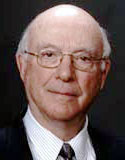|

3528 General (ret’d) Paul Manson RMC, Class of 1956
Marsh says
the policy statement ignores fundamental issues confronting
the Canadian military, not least of which is a projected
$1.1-billion operating deficit among the three services this
year.
February's
federal budget promised $12.8 billion in new defence spending
over five years, but most of that won't flow until 2009-2011.
This year's one-time increase to a $13-billion budget is only
$500 million.
Marsh says
that's not nearly enough to address the damage caused by years
of neglect that began with 1990s cost-cutting, let alone
rising operating costs.
"There is
little acknowledgement of the serious deficits in equipment,
personnel, realty assets, command, intelligence, support and
national procurement - not a complete list," he writes.
"The
defence paper assumes that transformation is achievable by
emphasizing the future and minimizing these legacy issues."
Released
April 19 as part of a broad international policy review, the
government's defence policy statement promised a
better-equipped, more efficient and more effective military at
home and abroad within five years.
The
government wants to double Canada's overseas capability, forge
a stronger continental defence with the United States and
assert Canada's sovereignty in the Arctic.
To do so,
it says it will hire 5,000 more full-time and 3,000 part-time
personnel, reorganize its command-control structure, form a
special operations task force and buy new ships, aircraft and
vehicles.
Marsh says
fact sheets that accompany the government document are
"misleading," appearing to inflate the Forces' payroll by
23,000 full-time personnel.
The sheets
claim 62,500 soldiers, sailors and air crew but they don't
specify how many are full-time, reservists or recruits. A
Defence Department spokesman said Monday the military's
trained effective strength is 53,472.
Marsh says
there are actually 39,500 full-timers in the military. He
notes the figure 62,500 happens to coincide with the Forces'
ceiling. |
"It is not
clear whether the (government) totals comprise both regular
and reserve force members or whether the entry-level trainees
- recruits - have been apportioned to the three services," he
writes.
"Regardless . . . it makes the reader wary of other positive
claims in the paper."
However,
numbers provided by the Defence Department on Monday indicate
the two may be closer than they first appear.
The 62,500
figure - actually 61,534 on April 1 - includes uniformed
administrators such as human resources, materiel and
information management staff, said Jae Malana, a department
spokesman.
The actual
total number of combat forces in the three services as of
April 1 was 44,657 - 5,000 more than Marsh estimates. The
disparity is within the annual fluctuation the military
expects, said Malana.
There are
22,280 more reservists.
"They are
living figures, they do fluctuate," Malana said.
The policy
document requires a level of military integration rarely, if
ever, achieved outside of wartime, much less under an unstable
minority government, says Marsh's analysis.
"If this
large-scale integration of effort is hobbled by a lack of
focus or experience, policy implementation will surely be
delayed, inadequately carried out, or made impossible."
Some of
Marsh's concerns are echoed by the commanders of all three
services in their annual economic impact assessments. They
issue dire warnings and desperate pleas for more money,
equipment and personnel.
Gen. Rick
Hillier himself, now the chief of defence staff, wrote in his
former role as head of the army that he feared goals may
exceed capabilities.
"The
emphasis on resource priorities has clearly shifted," Hillier
wrote in December, "yet the sustainment base has not been
provided the necessary resources."
The
Conference of Defence Associations is a non-profit think tank
and lobby group representing 31 defence-related associations.
Marsh's
paper is endorsed by two retired generals, including a former
chief of defence staff, Paul Manson. |